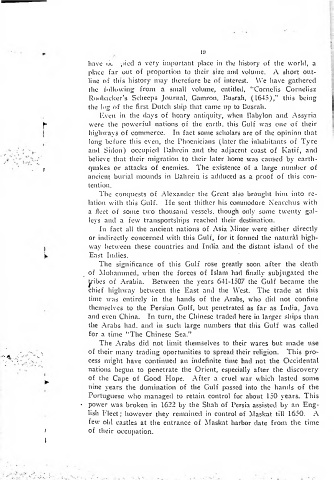Page 357 - Neglected Arabia (1911-1915)(Vol 1)
P. 357
.
1‘)
have ul- ,>iocl a very important place in the history of the world, a
place far out of proportion to their size and volume. A short out
line of this history may therefore be of interest. We have gathered
the following from a small volume, entitled, ‘'Cornell’s Cornelisz ;
Roohacker’s Scheeps Journal, Gamron, Busrah, (1645),” this being
the log of the first Dutch ship that came up to Busrah.
Even in the days of hoary antiquity, when Babylon and Assyria
r were the powerful nations of the earth, this Gulf was one of their
highways of commerce. In fact some scholars arc of the opinion that
long before this even, the Phoenicians (later the inhabitants of Tyre
y and Sidon) occupied Bahrein and the adjacent coast of Katif, and
believe that their migration to their later home was caused by earth
quakes or attacks of enemies. The existence of a large number of
l
ancient burial mounds in Bahrein is adduced as a proof of this con
tention.
The conquests of Alexander the Great also brought him into re
lation with this Gulf. He sent thither his commodore Xearchus with
a fleet of some two thousand vessels, though only some twenty gal
leys and a few transportships reached their destination.
In fact all the ancient nations of Asia Minor were either directly
or indirectly concerned with this Gulf, for it formed the natural high
way between these countries and India and the distant island of the
► East Indies.
The significance of this Gulf rose greatly soon after the death
of Mohammed, when the forces of Islam had finally subjugated the
Jribes of Arabia. Between the years 641-1507 the Gulf became the
chief highway between the East and the West. The trade at this
time was entirely in the hands of the Arabs, who did not confine
themselves to the Persian Gulf, but penetrated as far as India. Java
and even China. In turn, the Chinese traded here in larger ships than
the Arabs had. and in such large numbers that this Gulf was called
for a time ‘‘The Chinese Sea/1
The Arabs did not limit themselves to their wares but made use
of their many trading oportunities to spread their religion. This pro
*:\V: •- cess might have continued an indefinite time had not the Occidental
nations begun to penetrate the Orient, especially after the discovery
of the Cape of Good Hope. After a cruel war which lasted some
►
nine years the domination of the Gulf passed into the hands of the
Portuguese who managed to retain control for about 150 years. This
• power was broken in 1622 by the Shah of Persia assisted by an Eng
lish Fleet; however they remained in control of Maskat till 1650. A
few old castles at the entrance of Maskat harbor date from the time
I of their occupation.
\

